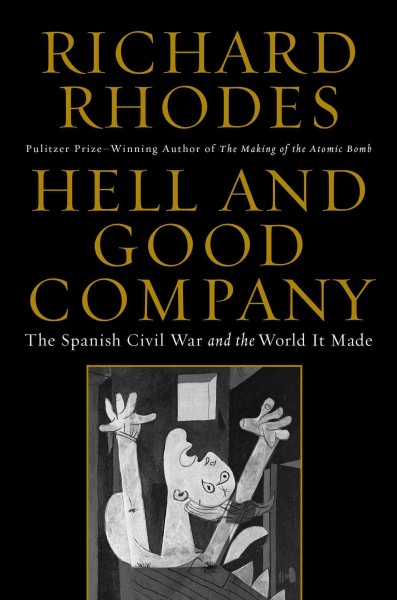 Richard Rhodes’ Hell and Good Company is the title for the October History Book Group (meeting Oct 19 at 7) and being more organized that I usually am I set down to read it well in advance. I have always found the Spanish Civil War fascinating. For one its a dress rehearsal for World War II and second because it was so important internationally to so many governments and individuals. Beginning in 1935 with the revolt of General Francisco Franco and much of the Spanish army’s officer corp against the elected republican government of Spain the war rapidly sucked in officially and non-officially. Nazi Germany and Italy quickly moved to back Franco. The Soviet Union moved to support the Republic government. England and the USA refused to back any side and France waffled back and forth between being neutral and somewhat supporting the Republicans. Simultaneously private citizens from all over Europe rushed to volunteer to serve in International Brigades in the Republican army to fight against Franco and Fascism. Franco’s army with the direct aid of Italy and Germany and the neglect of the Republicans by England, France and the US won in 1939.
Richard Rhodes’ Hell and Good Company is the title for the October History Book Group (meeting Oct 19 at 7) and being more organized that I usually am I set down to read it well in advance. I have always found the Spanish Civil War fascinating. For one its a dress rehearsal for World War II and second because it was so important internationally to so many governments and individuals. Beginning in 1935 with the revolt of General Francisco Franco and much of the Spanish army’s officer corp against the elected republican government of Spain the war rapidly sucked in officially and non-officially. Nazi Germany and Italy quickly moved to back Franco. The Soviet Union moved to support the Republic government. England and the USA refused to back any side and France waffled back and forth between being neutral and somewhat supporting the Republicans. Simultaneously private citizens from all over Europe rushed to volunteer to serve in International Brigades in the Republican army to fight against Franco and Fascism. Franco’s army with the direct aid of Italy and Germany and the neglect of the Republicans by England, France and the US won in 1939.
Rhodes is honest up front that the main focus of the book will be on technological innovations in the war and individuals fighting in it. True to his word the reader gets only the bare minimum of back ground information on the politics of the war and technology is where this book really shines. He highlights the perfecting and fine tuning of new weapons like airplanes and tanks on the battle fields of Spain. Ideas like carpet bombing cities to demoralize the civilian populations, something that would become common place in World War II, were first used in the Spanish Civil War. The tank tactics that Germany and Russia used in World War II were worked out on the battle fields of Spain. The large scale collection, storage and decimation of blood for transfusions was perfected during the war as well.
The second area of interest for Rhodes is the individual lives of individuals in the war. He discusses at length the experiences of such authors as Earnest Hemingway, Martha Gelhorn and John Dos Passos and hundreds more who flocked to the Republic side as soldiers and correspondents. He also looks at the infamous who joined as well. Workers from trade unions, communists or just progressives who wanted to fight fascism they are all there. Rhodes does a great job of showing us their day to day lives from fighting classroom to classroom in University City in the siege of Madrid to life of correspondents at the Hotel Florida. He also gives the reader a play by play commentary on the creation of Picaso’s Guernica.
Picaso’s role in the book highlights one of its short comings. There are very few Spaniards in the book. Most are faceless and their presence is implied or they are famous like Picaso. Often the book feels like a combination of a history of the International Brigades and a medical history of the war. However that said what he does cover he covers very well. Anyone with a basic knowledge of the Spanish Civil War would get a lot out of this book.


